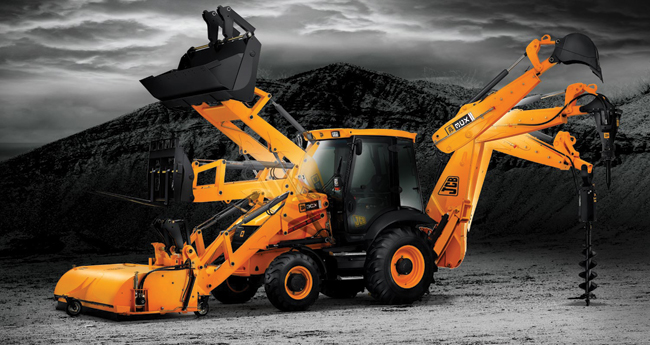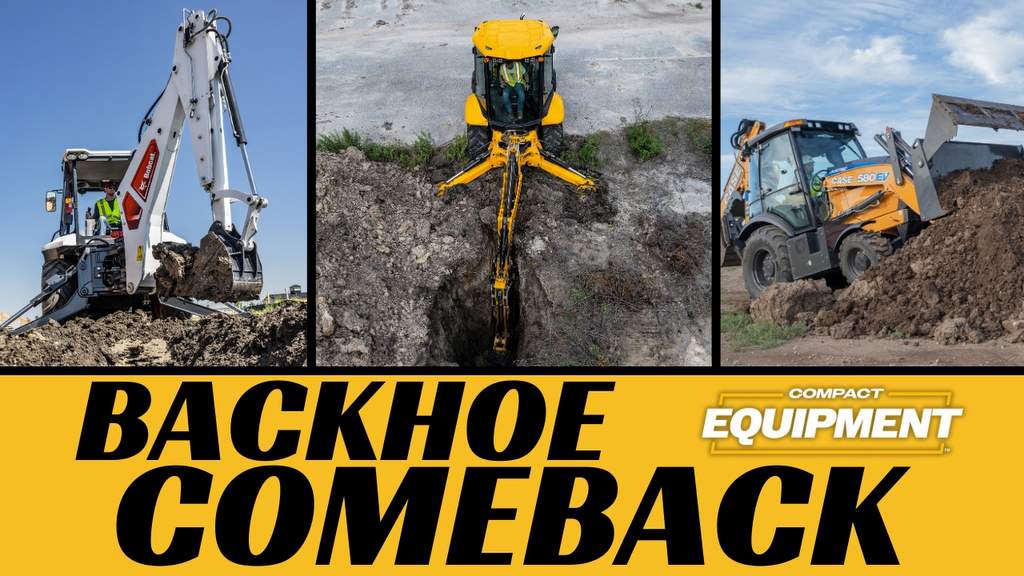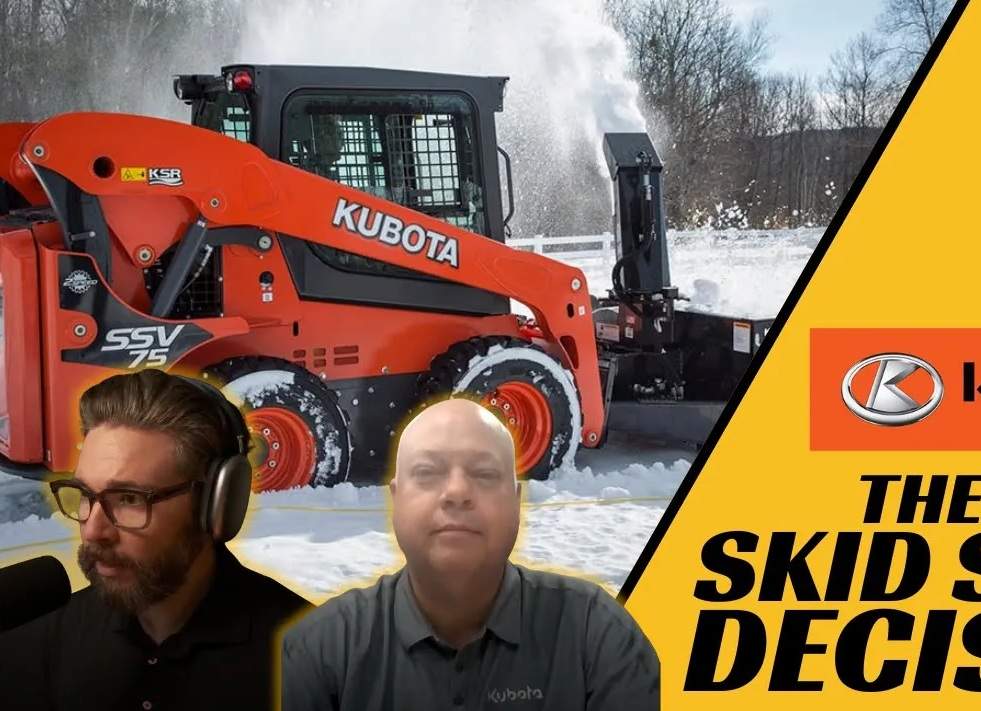This Ain’t Your Granddaddy’s Backhoe
With buckets on both ends, a backhoe loader became famous for specializing in the two essentials of construction — digging and loading. With the simple swing of the seat, an operator can go from digging a 14-ft deep trench to transporting all those spoils into a steely dump truck. But today dig and load are not always a priority, in which case a backhoe’s buckets (on each end) can usually be removed and replaced with hydraulically operated attachments (breakers, pallet forks, grapples, augers and beyond) to spearhead a variety of side projects.

This dual bucket philosophy plus attachment expandability has made the backhoe loader a staple on construction sites around the globe. The history of the backhoe loader goes back 50-plus years. On separate sides of the pond, both Case and JCB began tinkering with ideas of a dig-and-load combo machine for the construction industry. In England, JCB launched its first backhoe loader, the MK1 excavator in 1953, utilizing a Fordson tractor with a hydraulic excavator fitted to the rear and a JCB major loader to the front. In the spring of 1957, Case introduced the landmark Case Model 320, the first tractor loader backhoe fully integrated from the factory and warranted by the manufacturer, and began its backhoe loader production in Burlington, Iowa
“The loader backhoe’s versatility makes it a popular choice for a wide variety of applications and markets, including light and heavy construction, utility work, landscaping and agricultural applications,” explains Katie Pullen, brand marketing manager with Case Construction Equipment. “By combining the roading and loading capabilities of a compact wheel loader and the trenching and lifting capability of a compact excavator, loader backhoes enable contractors to get two machines in one.”
Today, there are plenty of big manufacturing companies producing backhoe loaders — Terramite, Kubota, JCB, Volvo, John Deere, Case, New Holland and more. These machines are categorized by dig depth — the most common being 14 ft. In this article, we’ll cover everything 14 ft and below, which we’ll classify as the compact market. Many compact backhoe loaders fall into different size categories, including less than 6-ft, 6- to 9-ft, 9- to 11-ft and 11- to 14-ft dig depths.
In all of those depth categories, backhoe loaders still cover a wide range of specifications — 20- to 130-hp engines (usually diesel), operating weights from 3,000 to 27,000 lbs and bucket breakout capacities from 3,000 to 11,000 lbs. Pricing also ranges from $15,000 to $40,000 for compacts and $50,000 to over $100,000 for the biggest and most luxurious models.
“For smaller backhoes, they are popular in areas where size is a constraint,” says Chris Giorgianni, vice president of products at JCB. “When you look at today’s general backhoes, over they years they’ve grown, and they’re a lot bigger than earlier predecessors. Our smallest 1CX JCB backhoe for example is a machine like a skid steer that can spin turn within its machine size, so you get extra versatility to work in a confined area. Coupled with that is the versatility of a universal quick-hitch that can pick up skid steer attachments.”
The majority of the time backhoe loaders are used to dig, so the backhoe boom and bucket area will be the most important factor. Most general backhoe buckets fall into the 60- to 80-in. bucket range and include general purpose buckets, multi-purpose buckets, grapple buckets, industrial buckets, light material buckets, heavy-duty buckets, 4-in-1 buckets, clamshell buckets and narrow buckets.
There are often two main types of boom configurations on backhoe loaders — curved and straight. The straight boom gives operators more reach when it comes to straight out digging, and since most jobs for compact backhoe loaders involve trench applications, this means less repositioning for the operator. A curved boom gives operators better digging geometry. With a curved, excavator-style boom, crews will find it easier to clear worksite obstacles and that truck loading is better because you can easily clear sideboards and position material in the center of the bed. There are also unique boom designs on the market.
“The Case backhoe boom design is unique in the industry in two key respects,” Pullen says. “The Case backhoe boom is narrow, allowing a clear view to the bucket and the worksite, which makes it easier for the operator to avoid worksite accidents. It also locks into an over-center position that reduces porpoising and provides better balance during roading and trailering.”

Moving to the loader in the front of the machine, renters and buyers should ensure the front loader has the lift capacity with a bucket or pallet forks mounted. The front loader must have enough lift height to clear the sides of a loading bin or truck. Running the front bucket means moving the backhoe loader around a jobsite, so consider the cab, visibility and drive-ability. Look at the type of transmission — a hydrostatic transmission will be easier to use than a manual gearbox (though more expensive). Other options like ride control, parallel lift and travel speed (some up to 25 mph) are important considerations. Four-wheel drive, all-wheel drive, crab steer and differential lock improve mobility in mud, sand, snow and in tight quarters; two-wheel drive is typically available and always cheaper.
A loader quick-coupler of the front would be important if changing attachments occurs regularly (specialty buckets, pallet forks and planers are popular). Implements can also sometimes run of the backhoe boom as well (breakers, augers and grapples are available).
“Customers are looking for ways to stretch their dollars with a versatile backhoe, which is why attachments are key for customers,” explains Louann Hausner, product marketing manager for backhoes and tractor loaders at John Deere Construction and Forestry. “Coupled with a hydraulic quick-coupler, operators can increase their productivity by saving time in being able to easily attach and detach from loader attachments without having to leave the cab.”
Versatility, like quality, is a relative concept, but there are plenty of fair criteria on which to judge both a new or used backhoe loader — safety, design, power, fuel economy and price are just a few examples. A good start is to ask for a demo unit to run the compact backhoe loader through a few paces on a jobsite. While testing a variety of units, be sure to consider all the ideas mentioned.
Overall, it’s important to realize the capabilities and limitations of any machine. For example, understanding a compact backhoe loader’s carrying capacities and hydraulic requirements will ensure that you don’t overextend the unit. When buying smaller, it’s always important to find a right-sized model.
“The backhoe loader is not necessarily great at doing one job, but it’s very good at multitasking,” says Giorgianni. “It comes down to applications — what you do, how you want to do it and what timeframe you want to do it in. When you’re thinking about the job, you need to find the machine that gives you maximum utilization.”
Keith Gribbins is managing editor of Compact Equipment, based in Peninsula, Ohio.
Before You Buy
Be Sure to Explore the 10 Questions Below
- Hydraulic attachment operation — single or multi-function?
- How simple is the machine instrumentation?
- What’s the fuel economy and tank capacity?
- Controls — are they simple with little effort?
- Is there a smooth ride while traveling?
- How easy is entry and exit?
- Operator space — is it comfortable for larger operators?
- Do you need to jump off the machine to switch from backhoe to loader functions?
- What’s the visibility like from both the loader and backhoe operating positions?
- Oh yeah, how much does it cost?




